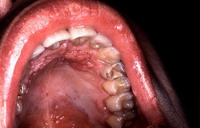America sets new record for sexually contracted diseases
United States is under attack of 1 million cases of chlamydia - a sexually transmitted disease.

"A new U.S. record," said Dr. John M. Douglas Jr. of the Centers for Disease Control and Prevention.
More bad news: Gonorrhea rates are jumping again after hitting a record low, and an increasing number of cases are caused by a "superbug" version resistant to common antibiotics, federal officials said Tuesday.
Syphilis is rising, too. The rate of congenital syphilis - which can deform or kill babies - rose for the first time in 15 years.
"Hopefully we will not see this turn into a trend," said Dr. Khalil Ghanem, an infectious diseases specialist at Johns Hopkins University's School of medicine.
The CDC releases a report each year on chlamydia, gonorrhea and syphilis, three diseases caused by sexually transmitted bacteria.
Chlamydia is the most common. Nearly 1,031,000 cases were reported last year, up from 976,000 the year before.
The count broke the single-year record for reported cases of a sexually transmitted disease, which was 1,013,436 cases of gonorrhea, set in 1978.
Putting those numbers into rates, there were about 349 cases of chlamydia per 100,000 people in 2006, up 5.6 percent from the 329 per 100,000 rate in 2005.
CDC officials say the chlamydia record may not be all bad news: They think the higher number is largely a result of better and more intensive screening.
For more than 10 years, the CDC has recommended annual screening in sexually active women ages 15 to 25. Meanwhile, urine and swab tests for the bacteria are getting better and are used more often, for men as well as women, said Douglas, director of the CDC's Division of Sexually Transmitted Disease Prevention.
About three-quarters of women infected with chlamydia have no symptoms. Left untreated, the infection can spread and ultimately can lead to infertility. It's easily treated if caught early.
Health officials believe as many as 2.8 million new cases may actually be occurring each year, he added.
Gonorrhea is a different story.
In 2004, the nation's gonorrhea rate fell to 113.5 cases per 100,000 people in 2004, the lowest level since the government started tracking cases in 1941.
But since then, health officials have seen two consecutive years of increases. The 2006 rate - about 121 per 100,000 - represents a 5.5 percent increase from 2005.
Health officials do not know exactly how many superbug cases there were among the more than 358,000 gonorrhea cases reported in 2006. But a surveillance project of 28 cities found that 14 percent were resistant to ciprofloxacin and other medicines in the fluoroquinolones class of antibiotics.
Similar samples found that 9 percent were resistant to those antibiotics in 2005, and 7 percent were resistant in 2004. The appearance of the superbug has been previously reported, and the CDC is April advised doctors to stop using those drugs against gonorrhea.
Douglas said it does not look like the superbugs are the reason for gonorrhea's escalating numbers overall, but they are not sure what is driving the increase.
Other doctors are worried. The superbug gonorrhea has been on the rise not only in California and Hawaii, where the problem has been most noticeable, but also in the South and parts of the Midwest.
"Suddenly we're starting to see the spread," Ghanem said.
Syphilis, a potentially deadly disease that first shows up as genital sores, has become relatively rare in the United States. About 9,800 cases of the most contagious forms or syphilis were reported in 2006, up from about 8,700 in 2005.
The rate rose from 2.9 cases per 100,000 people to 3.3, a 14 percent increase.
For congenital syphilis, in which babies get syphilis from their mothers, the rate rose only slightly from the previous year to 8.5 cases per 100,000 live births.
Subscribe to Pravda.Ru Telegram channel, Facebook, RSS!





